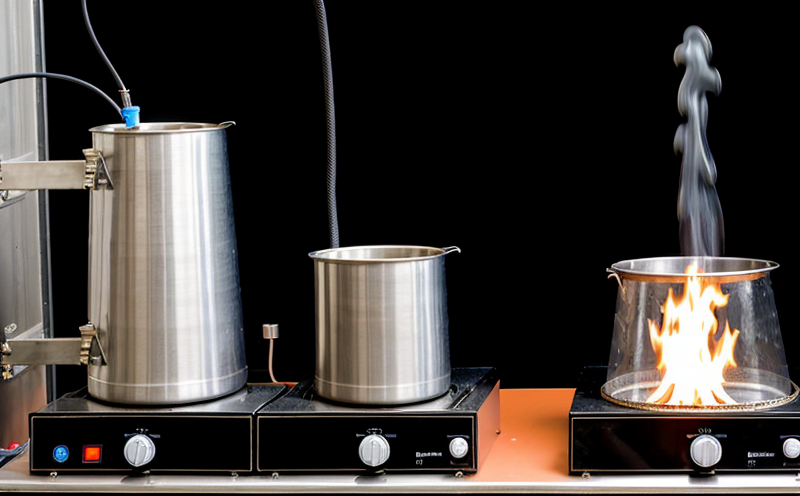Heat Release Testing of Household Appliances
In today’s world, household appliances play a significant role in daily life. They are designed to make our lives easier and more convenient. However, the materials used in their construction can pose fire safety risks if not properly evaluated. Heat release testing is an essential procedure that ensures these products meet stringent safety standards.
Heat release testing measures how much heat a material generates when exposed to fire. This test is critical for understanding the combustion behavior of household appliances, which helps in identifying potential hazards and ensuring compliance with relevant regulations and standards. By conducting this type of testing, manufacturers can enhance product safety, reduce liability risks, and meet consumer expectations.
The process typically involves exposing a specimen (the appliance or its components) to controlled heat sources under specific conditions. The apparatus used may include oxygen index testers, cone calorimeters, or other specialized equipment designed to simulate real-world fire scenarios accurately. During testing, various parameters such as the rate of heat release, smoke density, and flame spread are monitored.
Understanding these metrics is crucial for assessing whether a product complies with local regulations like NFPA 91, ISO 5636-2, or EN 30-1. Compliance ensures that consumers can trust the products they purchase, knowing they have been rigorously tested to minimize fire risks.
Moreover, heat release testing helps manufacturers improve their designs and materials selection processes by providing valuable insights into which elements contribute most significantly to flame spread or smoke generation. This information allows companies to innovate safer products without compromising functionality or aesthetics.
The importance of this service cannot be overstated, especially given the increasing trend towards more energy-efficient appliances that might use alternative materials with different flammability characteristics compared to traditional ones. By leveraging heat release testing early in the design phase, manufacturers can identify and address potential issues before they become costly problems during production or after-market recalls.
Furthermore, conducting thorough heat release tests demonstrates a commitment to safety and quality assurance that resonates well with both consumers and regulatory bodies alike. In an era where public awareness about product safety continues to grow, companies who invest in such testing not only protect their reputations but also contribute positively towards creating safer environments for everyone.
With this comprehensive approach to heat release testing, we help ensure that every household appliance leaves our laboratory fully compliant with all relevant fire safety standards. Our experienced team uses advanced techniques and cutting-edge equipment to deliver accurate results that are trusted by industry leaders worldwide.
Quality and Reliability Assurance
Ensuring the quality and reliability of household appliances is crucial for maintaining consumer trust and satisfaction. At our laboratory, we employ rigorous testing methodologies to verify that each product meets or exceeds industry standards set forth by organizations like NFPA 91, ISO 5636-2, and EN 30-1.
Our heat release tests provide valuable data on the combustion behavior of various materials used in appliance construction. This information is then utilized to fine-tune manufacturing processes and material choices, ultimately leading to more reliable products with improved fire safety performance.
We also offer a range of additional services designed specifically for quality control purposes, including accelerated aging tests that simulate years of use under extreme conditions. By incorporating these tests into the development cycle, manufacturers can catch any latent defects early on and make necessary adjustments before full-scale production begins.
The reliability aspect extends beyond just meeting minimum requirements; it involves ensuring consistent performance across all units produced. Through meticulous quality assurance measures, we guarantee that every appliance leaving our facility is not only safe but also dependable in real-world applications.
Customer Impact and Satisfaction
Consumer confidence plays a vital role in the success of any brand, particularly when it comes to household appliances where safety is paramount. By investing in thorough heat release testing and other quality assurance protocols, we help manufacturers build trust with their customers.
When consumers know that their appliances have been rigorously tested against recognized standards like NFPA 91 or ISO 5636-2, they feel safer using them. This increased confidence translates directly into higher customer satisfaction levels and stronger brand loyalty.
In today’s competitive market, where information about product safety is readily accessible online, having a reputation for producing reliable fire-safe appliances can differentiate brands significantly. Positive reviews from satisfied customers further reinforce this positive image, creating a virtuous cycle of improved sales performance and continued customer satisfaction.
Beyond mere compliance with regulations, our commitment to quality and reliability also extends to ongoing support after the initial purchase. Regular follow-up services ensure that products continue to perform optimally over time, addressing any emerging issues promptly through proactive maintenance plans.
Competitive Advantage and Market Impact
In a highly competitive market, standing out from the crowd requires more than just meeting basic requirements; it necessitates setting new benchmarks for excellence. For manufacturers seeking to gain a competitive edge in the appliance industry, investing in advanced heat release testing offers several key advantages.
Firstly, it enables them to stay ahead of regulatory changes by anticipating future trends and ensuring compliance before they are even officially mandated. This foresight allows companies to maintain a leading position within their respective markets.
Secondly, superior heat release testing results contribute significantly to brand reputation-building efforts. Demonstrating a strong commitment to safety not only enhances brand perception but also attracts investors looking for sustainable growth opportunities. A reputable company is more likely to attract long-term partnerships and collaborations, fostering sustained success in the industry.
Thirdly, these tests provide valuable feedback that can be used during product development stages to enhance innovation capabilities continuously. By identifying areas where improvements are needed early on, manufacturers can introduce new features or refinements that set their products apart from competitors' offerings.





